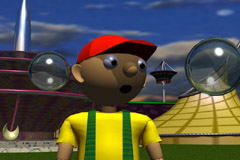Up
Next
Introduction
Plateau
History
Visualization
Architecture
Crystallography
Weierstraß
Properties 1
Properties 2
Properties 3
Symmetry
Alteration
Periodic
Handles
Production
Scenes 1
Scenes 2
Scenes 3
Results
Exhibition
Numerics
References
Web Links
|
Introduction

|
|
Fig 1. Kalle watching soap
bubbles. Buildings have light-weight roofs in the shape
of soap films.
Video (
8.6MB,
2.3MB)
|
A magical fascination arises from seeing colorful soap
bubbles flying in the wind. The observer is immediately attracted while
watching the beautiful creations and he can imagine touching them with a
satisfying childlike curiosity. Yet behind these aesthetically pleasing
shapes lie deep mathematical problems, as well as practical applications
in architecture, physics and chemistry - which one can understand and
appreciate, in spite of their complexity, via the amusing story that
unfolds in this video.

|
|
Young Boy Kalle.
|
The shape of a round bubble is only the simplest
example of an incredible wealth of shapes that arise with soap films.
Imagine a simple experiment with soap films in the kitchen:
dip a curved metal wire into a mixture of water and dish-washing
detergent, and, when you cautiously pull it out, a soap films forms. With
amazing elegance and simplicity, this soap film solves a historic
mathematical problem, namely, the soap film finds the least surface area
amongst all imaginable surfaces spanned by the wire. Therefore,
mathematicians call them "minimal surfaces" since they minimize area.
|

